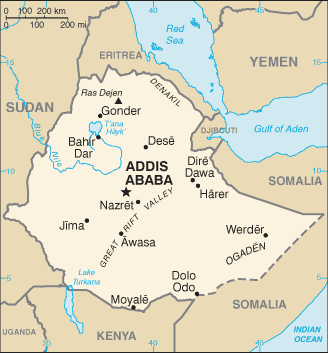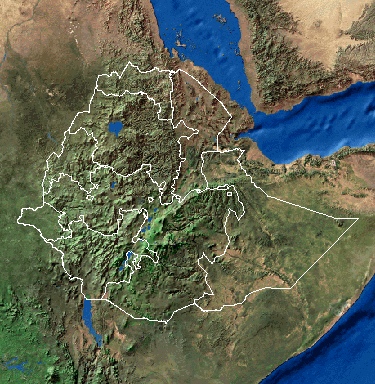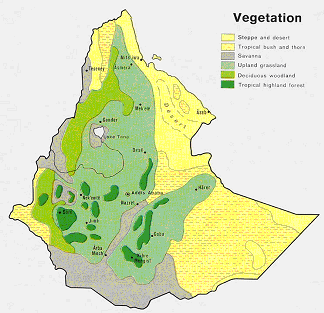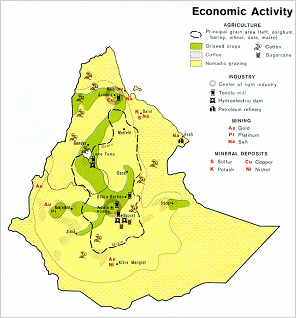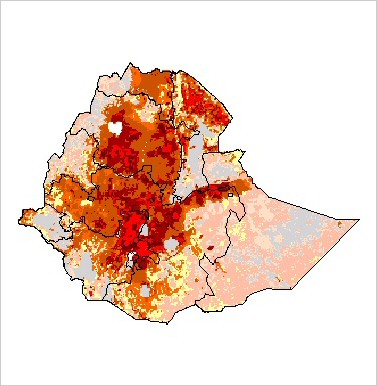|
|
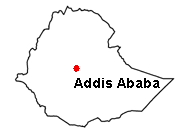 |
| |
back to top | ||
|
Population. In 1975 the population was estimated to be 1000 animals and it was believed that the populations could decline to 300 animals by 1980. The cheetah was widely distributed from Addes to Djibouti in eastern Ethiopia. Also widely distributed through the southern parts of the country, between 200-1500m elevation, absent from the low lands of the Ogaden in the east, and no sightings in the north since 1937. A small population was known to be in the Danakil Reserve. In 1995, cheetahs were sited near Dolo. Two cheetahs were seen in the dry desert scrub, 100km from Dolo, by American oil company employees. The cheetahs were seen on a rocky plateau. This area has a fairly large antelope prey population. Other cheetah sightings have recently been in the Afder Zone, in and around the CherriHi/El Kere area, and in the Dolo region skins and live cheetah are offered for sale. One cheetah from the Dolo region is in captivity at the Royal Palace as of 1996. Cheetahs are protected against hunting and capture although legislation is difficult to enforce. According to a report in 2002, the cheetah seems to be still numerous in the west Mille district of the Afar region (Werdanso region). Principal Threats. Civil war, habitat loss, extensive poaching, decline of prey, and fur trade. |
|||
|
|
|||
|
|||
|
Background: Unique among African countries, the ancient Ethiopian monarchy maintained its freedom from colonial rule with the exception of the 1936-41 Italian occupation during World War II. In 1974, a military junta, the Derg, deposed Emperor Haile SELASSIE (who had ruled since 1930) and established a socialist state. Torn by bloody coups, uprisings, wide-scale drought, and massive refugee problems, the regime was finally toppled in 1991 by a coalition of rebel forces, the Ethiopian People's Revolutionary Democratic Front (EPRDF). A constitution was adopted in 1994, and Ethiopia's first multiparty elections were held in 1995. A border war with Eritrea late in the 1990's ended with a peace treaty in December 2000. Final demarcation of the boundary is currently on hold due to Ethiopian objections to an international commission's finding requiring it to surrender territory considered sensitive to Ethiopia. |
|||
| |
back to top |
|
Area: total: 1,127,127 sq km; land: 1,119,683 sq km; water: 7,444 sq km Climate: tropical monsoon with wide topographic-induced variation Terrain: high plateau with central mountain range divided by Great Rift Valley Natural resources: small reserves of gold, platinum, copper, potash, natural gas, hydropower Land use: arable land: 10.01%; permanent crops: 0.65%; other: 89.34% (2005) Irrigated land: 2,900 sq km (2003) Natural hazards: geologically active Great Rift Valley susceptible to earthquakes, volcanic eruptions; frequent droughts |
|
|
|
|
Environment - current issues: deforestation; overgrazing; soil erosion; desertification; water shortages in some areas from water-intensive farming and poor management Environment - international agreements: party to: Biodiversity, Climate Change, Desertification, Endangered Species, Hazardous Wastes, Ozone Layer Protection; signed, but not ratified: Environmental Modification, Law of the Sea |
|
| |
back to top | |
|
Population: 74,777,981; note: estimates for this country explicitly take into account the effects of excess mortality due to AIDS; this can result in lower life expectancy, higher infant mortality and death rates, lower population and growth rates, and changes in the distribution of population by age and sex than would otherwise be expected (July 2006 est.) Age structure: 0-14 years: 43.7% (male 16,373,718/female 16,280,766); 15-64 years: 53.6% (male 19,999,482/female 20,077,014); 65 years and over: 2.7% (male 929,349/female 1,117,652) (2006 est.) Median age: total: 17.8 years; male: 17.7 years; female: 17.9 years (2006 est.) Population growth rate: 2.31% (2006 est.) Infant mortality rate: total: 93.62 deaths/1,000 live births; male: 103.43 deaths/1,000 live births; female: 83.51 deaths/1,000 live births (2006 est.) Life expectancy at birth: total population: 49.03 years; male: 47.86 years; female: 50.24 years (2006 est.) Total fertility rate: 5.22 children born/woman (2006 est.) |
|
|
HIV/AIDS - adult prevalence rate: 4.4% (2003 est.) HIV/AIDS - people living with HIV/AIDS: 1.5 million (2003 est.) HIV/AIDS - deaths: 120,000 (2003 est.) Ethnic groups: Oromo 40%, Amhara and Tigre 32%, Sidamo 9%, Shankella 6%, Somali 6%, Afar 4%, Gurage 2%, other 1% Religions: Muslim 45%-50%, Ethiopian Orthodox 35%-40%, animist 12%, other 3%-8% Languages: Amharic, Tigrinya, Oromigna, Guaragigna, Somali, Arabic, other local languages, English (major foreign language taught in schools) Literacy: definition: age 15 and over can read and write; total
population: 42.7%; male: 50.3%; female: 35.1% (2003 est.) |
||
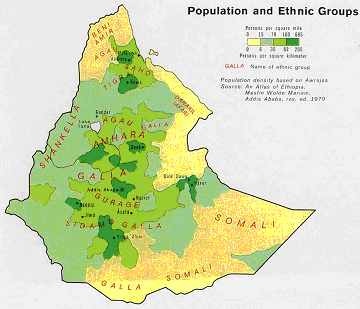 |
|
Ethnic groups: Oromo 40%, Amhara and Tigre 32%, Sidamo 9%, Shankella 6%, Somali 6%, Afar 4%, Gurage 2%, other 1% Religions: Muslim 45%-50%, Ethiopian Orthodox 35%-40%, animist 12%, other 3%-8% Languages: Amharic, Tigrinya, Oromigna, Guaragigna, Somali, Arabic, other local languages, English (major foreign language taught in schools) Literacy: definition: age 15 and over can read and write; total population: 42.7%; male: 50.3%; female: 35.1% (2003 est.) |
| |
back to top |
|
Data Code: ET Government type: federal republic Independence: oldest independent country in Africa and one of the oldest in the world - at least 2,000 years Legal system: currently transitional mix of national and regional courts Political pressure groups and leaders: Ethiopian People's Patriotic Front or EPPF; Ogaden National Liberation Front or ONLF; Oromo Liberation Front or OLF [DAOUD Ibsa] |
|
| |
back to top | |
|
|
|
Economy - overview: Ethiopia's poverty-stricken economy is based on agriculture, accounting for half of GDP, 60% of exports, and 80% of total employment. The agricultural sector suffers from frequent drought and poor cultivation practices. Coffee is critical to the Ethiopian economy with exports of some $156 million in 2002, but historically low prices have seen many farmers switching to qat to supplement income. The war with Eritrea in 1998-2000 and recurrent drought have buffeted the economy, in particular coffee production. In November 2001, Ethiopia qualified for debt relief from the Highly Indebted Poor Countries (HIPC) initiative, and in December 2005 the International Monetary Fund voted to forgive Ethiopia's debt to the body. Under Ethiopia's land tenure system, the government owns all land and provides long-term leases to the tenants; the system continues to hamper growth in the industrial sector as entrepreneurs are unable to use land as collateral for loans. Drought struck again late in 2002, leading to a 2% decline in GDP in 2003. Normal weather patterns helped agricultural and GDP growth recover in 2004-06. |
|
GDP - real growth rate: 8.5% (2006 est.) GDP - composition by sector: agriculture: 49.2%; industry: 9.1%; services: 41.7% (2006 est.) Labor force: 27.27 million (1999) Labor force - by occupation: agriculture: 80%; industry: 8%; services: 12% (1985) Unemployment rate: NA% Population below poverty line: 50% (2004 est.) |
||
|
|
|
Agriculture - products: cereals, pulses, coffee, oilseed, cotton, sugarcane, potatoes, qat, cut flowers; hides, cattle, sheep, goats; fish Industries: food processing, beverages, textiles, leather, chemicals, metals processing, cement Industrial production growth rate: 6.7% (2001 est.) Exports: $1.085 billion f.o.b. (2006 est.) Exports - commodities: coffee, qat, gold, leather products, live animals, oilseeds Exports - partners: Germany 15.5%, China 10.5%, Japan 8.5%, Saudi Arabia 6.9%, Djibouti 6.8%, Switzerland 6.4%, Italy 5.9%, US 5.5%, Netherlands 4.2% (2005) Imports: $4.105 billion f.o.b. (2006 est.) Imports - commodities: food and live animals, petroleum and petroleum products, chemicals, machinery, motor vehicles, cereals, textiles Imports - partners: Saudi Arabia 14.7%, China 12.6%, US 12.4%, India 6.7%, Italy 4.6% (2005) |
|
Currency (code): birr (ETB) Exchange rates: birr per US dollar - 8.69 (2006), 8.68 (2005), 8.6356 (2004), 8.5997 (2003), 8.5678 (2002), note, since 24 October 2001 exchange rates are determined on a daily basis via interbank transactions regulated by the Central Bank |
||
| |
back to top |
|
Telephone system: general
assessment: adequate for government use Radio broadcast stations: AM 8, FM 0, shortwave 1 (2001) Television broadcast stations: 1 plus 24 repeaters (2002) Internet country code: .et Internet hosts: 88 (2006) Internet users: 113,000 (2005) |
|
| |
back to top |
|
Marker L., Malouf J. and Malouf A. 1999. Appendix 2: The status of the wild cheetah in its range countries. In: 1999 International Cheetah Studbook. http://www.lib.utexas.edu/maps/ethiopia.html |

